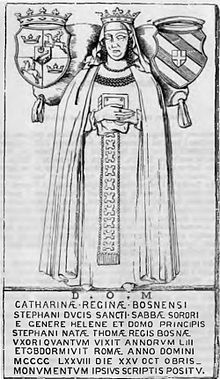| Catherine of Bosnia | |
|---|---|
 Ledger stone to Queen Catherine of Bosnia, depicting queen on a chest tomb, surrounded by the arms of her husband and father, in form of tomb effigy in shallow relief and ledger line. (reproduction from 1677)[1] | |
| Queen consort of Bosnia | |
| Tenure | May 1446 – 10 July 1461 |
| Born | 1424/1425 Blagaj, Kingdom of Bosnia |
| Died | (aged 53–54) Rome, Papal States |
| Burial | |
| Spouse | Stephen Thomas of Bosnia |
| Issue | |
| House | Kosača (paternally) Kotromanić (by marriage) |
| Father | Stjepan Vukčić Kosača |
| Mother | Jelena Balšić |
| Religion | Roman Catholic, convert from Bosnian Church |
Catherine of Bosnia (Serbo-Croatian: Katarina Kosača/Катарина Косача; 1424/1425 – 25 October 1478) was Queen of Bosnia as the wife of King Thomas, the penultimate Bosnian sovereign. She was born into the powerful House of Kosača, staunch supporters of the Bosnian Church. Her marriage in 1446 was arranged to bring peace between the King and her father, Stjepan Vukčić. The queenship of Catherine, who at that point converted to Roman Catholicism, was marked with an energetic construction of churches throughout the country.
Following her husband's death in 1461, Catherine's role receded to that of queen dowager at the court of her stepson, King Stephen Tomašević. Two years later, forces of the Ottoman Empire led by Mehmed the Conqueror invaded Bosnia and put an end to the independent kingdom. Catherine's stepson was executed, while Sigismund and Catherine, her son and daughter by Thomas, were captured and taken to Constantinople, where they converted to Islam. Queen Catherine escaped, taking refuge in Dubrovnik and eventually settling in Rome, where she received a pension from the papacy. From Rome she strove to be reunited with her children. Her efforts to negotiate and offer a ransom proved futile. She died a Franciscan tertiary in Rome, having named the papacy guardians of Bosnia and her children heirs to the throne, should they ever return to Christianity.
Queen Catherine remains one of the most important figures in the folk tradition and history of Bosnia and Herzegovina. She has long been venerated by the Catholics of Bosnia and Herzegovina, and is increasingly seen as an important transethnic state symbol.
- ^ Regan 2010, p. 60.